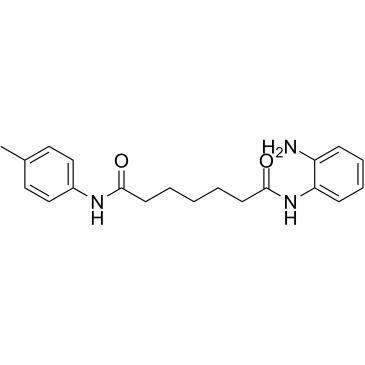Physicochemical Properties
| Molecular Formula | C20H25N3O2 |
| Molecular Weight | 339.4314 |
| Exact Mass | 339.194 |
| Elemental Analysis | C, 70.77; H, 7.42; N, 12.38; O, 9.43 |
| CAS # | 937039-45-7 |
| Related CAS # | Pimelic Diphenylamide 106 (analog);2070015-24-4 |
| PubChem CID | 16070100 |
| Appearance | White to yellow solid powder |
| Density | 1.2±0.1 g/cm3 |
| Boiling Point | 627.3±45.0 °C at 760 mmHg |
| Flash Point | 333.1±28.7 °C |
| Vapour Pressure | 0.0±1.8 mmHg at 25°C |
| Index of Refraction | 1.636 |
| LogP | 2.51 |
| Hydrogen Bond Donor Count | 3 |
| Hydrogen Bond Acceptor Count | 3 |
| Rotatable Bond Count | 8 |
| Heavy Atom Count | 25 |
| Complexity | 419 |
| Defined Atom Stereocenter Count | 0 |
| SMILES | O=C(CCCCCC(NC1C(N)=CC=CC=1)=O)NC1C=CC(C)=CC=1 |
| InChi Key | WTKBRPXPNAKVEQ-UHFFFAOYSA-N |
| InChi Code | InChI=1S/C20H25N3O2/c1-15-11-13-16(14-12-15)22-19(24)9-3-2-4-10-20(25)23-18-8-6-5-7-17(18)21/h5-8,11-14H,2-4,9-10,21H2,1H3,(H,22,24)(H,23,25) |
| Chemical Name | N'-(2-aminophenyl)-N-(4-methylphenyl)heptanediamide |
| Synonyms | TC-H 106, TC-H106, TC-H-106, TCH-106, TCH 106, TCH106, Histone Deacetylase Inhibitor VII, Pimelic Diphenylamide 106 |
| HS Tariff Code | 2934.99.9001 |
| Storage |
Powder-20°C 3 years 4°C 2 years In solvent -80°C 6 months -20°C 1 month |
| Shipping Condition | Room temperature (This product is stable at ambient temperature for a few days during ordinary shipping and time spent in Customs) |
Biological Activity
| References |
[1]. Pimelic diphenylamide 106 is a slow, tight-binding inhibitor of class I histone deacetylases. J Biol Chem. 2008 Dec 19;283(51):35402-35409. [2]. Chemical probes identify a role for histone deacetylase 3 in Friedreich's ataxia gene silencing. Chem Biol. 2009 Sep 25;16(9):980-989. |
| Additional Infomation | N'-(2-aminophenyl)-N-(4-methylphenyl)heptanediamide is an aromatic amine and an aromatic amide. |
Solubility Data
| Solubility (In Vitro) | DMSO : ~125 mg/mL (~368.26 mM) |
| Solubility (In Vivo) |
Solubility in Formulation 1: ≥ 0.55 mg/mL (1.62 mM) (saturation unknown) in 10% DMSO + 40% PEG300 + 5% Tween80 + 45% Saline (add these co-solvents sequentially from left to right, and one by one), clear solution. For example, if 1 mL of working solution is to be prepared, you can add 100 μL of 5.5 mg/mL clear DMSO stock solution to 400 μL PEG300 and mix evenly; then add 50 μL Tween-80 to the above solution and mix evenly; then add 450 μL normal saline to adjust the volume to 1 mL. Preparation of saline: Dissolve 0.9 g of sodium chloride in 100 mL ddH₂ O to obtain a clear solution. Solubility in Formulation 2: ≥ 0.55 mg/mL (1.62 mM) (saturation unknown) in 10% DMSO + 90% (20% SBE-β-CD in Saline) (add these co-solvents sequentially from left to right, and one by one), clear solution. For example, if 1 mL of working solution is to be prepared, you can add 100 μL of 5.5 mg/mL clear DMSO stock solution to 900 μL of 20% SBE-β-CD physiological saline solution and mix evenly. Preparation of 20% SBE-β-CD in Saline (4°C,1 week): Dissolve 2 g SBE-β-CD in 10 mL saline to obtain a clear solution. Solubility in Formulation 3: ≥ 0.55 mg/mL (1.62 mM) (saturation unknown) in 10% DMSO + 90% Corn Oil (add these co-solvents sequentially from left to right, and one by one), clear solution. For example, if 1 mL of working solution is to be prepared, you can add 100 μL of 5.5 mg/mL clear DMSO stock solution to 900 μL of corn oil and mix evenly. (Please use freshly prepared in vivo formulations for optimal results.) |
| Preparing Stock Solutions | 1 mg | 5 mg | 10 mg | |
| 1 mM | 2.9461 mL | 14.7306 mL | 29.4612 mL | |
| 5 mM | 0.5892 mL | 2.9461 mL | 5.8922 mL | |
| 10 mM | 0.2946 mL | 1.4731 mL | 2.9461 mL |
